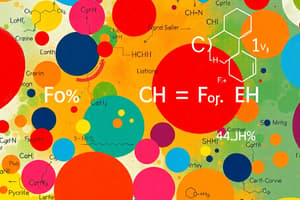Podcast
Questions and Answers
What is the percentage of iron (Fe) in iron(III) oxide (Fe2O3)?
What is the percentage of iron (Fe) in iron(III) oxide (Fe2O3)?
- 66.67%
- 72.00%
- 69.92% (correct)
- 70.25%
How many moles are present in a 125 g sample of aluminum (Al)?
How many moles are present in a 125 g sample of aluminum (Al)?
- 6.25 moles
- 5.00 moles
- 3.41 moles
- 4.63 moles (correct)
What is the empirical formula of a compound if its molecular formula is C6H12?
What is the empirical formula of a compound if its molecular formula is C6H12?
- C2H4
- CH2
- C6H12
- C3H6 (correct)
How many carbon atoms are in 1.0 carat of diamond, given that 1 carat is 0.2 g?
How many carbon atoms are in 1.0 carat of diamond, given that 1 carat is 0.2 g?
Which of the following statements regarding the mass percentage of a compound is true?
Which of the following statements regarding the mass percentage of a compound is true?
What is the rate law expression for the reaction of nitric oxide with Br2?
What is the rate law expression for the reaction of nitric oxide with Br2?
How is the value of x determined from the experimental data?
How is the value of x determined from the experimental data?
If the concentration of Br2 is doubled while keeping the concentration of NO constant, how does the rate of reaction change?
If the concentration of Br2 is doubled while keeping the concentration of NO constant, how does the rate of reaction change?
What value does y represent in the rate law, based on the provided data?
What value does y represent in the rate law, based on the provided data?
In which experimental setup can the value of x be calculated effectively?
In which experimental setup can the value of x be calculated effectively?
What does the double arrow in a chemical reaction signify?
What does the double arrow in a chemical reaction signify?
At equilibrium, what is true about the rates of the forward and reverse reactions?
At equilibrium, what is true about the rates of the forward and reverse reactions?
What does a large value of $K_c$ indicate about a chemical reaction?
What does a large value of $K_c$ indicate about a chemical reaction?
Which of the following factors does NOT affect the numerical value of the equilibrium constant $K$?
Which of the following factors does NOT affect the numerical value of the equilibrium constant $K$?
In the reaction $jA (g) + kB (g) \rightleftharpoons mC(g) + nD(g)$, how is the equilibrium constant $K$ defined?
In the reaction $jA (g) + kB (g) \rightleftharpoons mC(g) + nD(g)$, how is the equilibrium constant $K$ defined?
If the reaction results in a small value of $K_c$, what does it indicate?
If the reaction results in a small value of $K_c$, what does it indicate?
In a reaction with steps, which statement is correct regarding determining the equilibrium?
In a reaction with steps, which statement is correct regarding determining the equilibrium?
In the law of mass action for a reaction $jA + kB \rightleftharpoons mC + nD$, how can the equilibrium condition be expressed?
In the law of mass action for a reaction $jA + kB \rightleftharpoons mC + nD$, how can the equilibrium condition be expressed?
What will happen to the equilibrium position if H2 or I2 is removed from the reaction H2(g) + I2(g) ⇌ 2 HI(g)?
What will happen to the equilibrium position if H2 or I2 is removed from the reaction H2(g) + I2(g) ⇌ 2 HI(g)?
In the reaction SO2(g) + 2 O2(g) ⇌ 2 SO3(g), how does increasing pressure affect the equilibrium position?
In the reaction SO2(g) + 2 O2(g) ⇌ 2 SO3(g), how does increasing pressure affect the equilibrium position?
For a reaction where the change in the number of moles of gas (
$\Delta n$) is zero, what effect does changing the pressure have?
For a reaction where the change in the number of moles of gas ( $\Delta n$) is zero, what effect does changing the pressure have?
In an exothermic reaction with a negative $
\Delta H$ value, what is the effect of increasing temperature?
In an exothermic reaction with a negative $ \Delta H$ value, what is the effect of increasing temperature?
For which of the following reactions would increasing the temperature favor the forward reaction?
For which of the following reactions would increasing the temperature favor the forward reaction?
What effect does adding a catalyst have on a chemical equilibrium?
What effect does adding a catalyst have on a chemical equilibrium?
What is the effect of adding an inert gas to a system at equilibrium?
What is the effect of adding an inert gas to a system at equilibrium?
Which statement is true regarding changes in temperature and their effects on equilibrium?
Which statement is true regarding changes in temperature and their effects on equilibrium?
What happens to the rate of reaction as the concentration of the reactants increases?
What happens to the rate of reaction as the concentration of the reactants increases?
Which of the following factors does NOT affect the rate of a chemical reaction?
Which of the following factors does NOT affect the rate of a chemical reaction?
In the equation Rate = $-
rac{1}{2}
rac{ riangle[A]}{ riangle t}$, what does the '2' indicate?
In the equation Rate = $- rac{1}{2} rac{ riangle[A]}{ riangle t}$, what does the '2' indicate?
What effect does a catalyst have on a chemical reaction?
What effect does a catalyst have on a chemical reaction?
When considering the reaction 4NH3 + 5O2 -> 4 NO + 6 H2O, if ammonia reacts at a rate of 0.24 mole.L-1.s-1, what is the rate at which O2 reacts?
When considering the reaction 4NH3 + 5O2 -> 4 NO + 6 H2O, if ammonia reacts at a rate of 0.24 mole.L-1.s-1, what is the rate at which O2 reacts?
Which statement is true regarding the relationship between surface area and reaction rate?
Which statement is true regarding the relationship between surface area and reaction rate?
In the context of reaction rates, what is the 'order of the reaction' related to?
In the context of reaction rates, what is the 'order of the reaction' related to?
What does the rate constant 'K' depend on in a rate law?
What does the rate constant 'K' depend on in a rate law?
Flashcards are hidden until you start studying
Study Notes
Percentage composition of compounds
- The mass percentage of a component A can be found by dividing the mass of A by the total mass and multiplying by 100.
- For example, in Fe2O3, the percentage of Fe is 69.92%.
Empirical formula and Molecular formula
- The simplest formula of a compound is called the empirical formula.
- The molecular formula is a multiple of the empirical formula.
Classification of reactions
- Reactions can be classified as reversible or irreversible.
- In a reversible reaction, reactants react to become products and vice versa.
- At equilibrium, the rate of the forward reaction equals the rate of the backward reaction.
Law of mass action
- The rate of a reaction is proportional to the product of the concentrations of the reactants raised to their respective stoichiometric coefficients.
- The equilibrium constant Kc is the ratio of the rate constants for the forward and reverse reactions.
- Kc is influenced by temperature but not by the amounts of substances used or pressure changes.
- A large Kc value indicates a reaction that proceeds mostly to completion, while a small Kc indicates a reaction that favors the reverse reaction.
- Kc can be affected by temperature changes as well as by removing or adding specific components.
Le Chatelier’s principle
- The position of equilibrium in a reversible reaction is affected by changes in temperature, pressure, or concentration.
- Increasing the pressure (or decreasing the volume) shifts the equilibrium towards the side with fewer moles of gas.
- Increasing the temperature favors the endothermic reaction, while decreasing the temperature favors the exothermic reaction.
- The addition of a catalyst increases the speed at which equilibrium is reached but does not affect the equilibrium position.
- Adding an inert gas has no effect on the equilibrium position.
Reaction rates & their measurements
- The rate of a reaction is expressed as the change in concentration of a reactant or product over time.
- The stoichiometry of the reaction must be considered when calculating reaction rates.
Factors affecting the rate of chemical reaction
- Nature of the reactants: Some reactants react faster than others.
- Surface area: Increasing the surface area of reactants increases the rate of the reaction.
- Temperature: The rate of a reaction generally increases with temperature.
- Catalyst: Catalysts speed up reactions but do not affect the equilibrium position.
- Concentration: Increasing the concentration of reactants generally increases the rate of the reaction.
Rate laws
- The rate of a reaction is often proportional to the product of the concentrations of the reactants raised to some power.
- This relationship is known as the rate law.
- The rate constant K is a constant that is affected by temperature.
Determining the rate law
- By analyzing experimental data on reaction rates at different reactant concentrations, the rate law can be determined.
- To find the order of the reaction with respect to a particular reactant, compare the rates of experiments where the concentration of that reactant changes while other concentrations are kept constant.
- The order of the reaction is the value that makes the rates consistent.
Studying That Suits You
Use AI to generate personalized quizzes and flashcards to suit your learning preferences.




